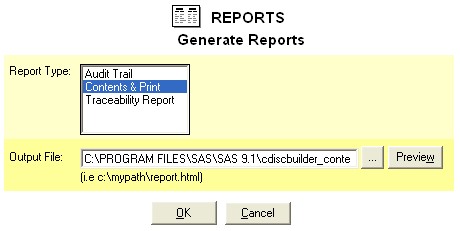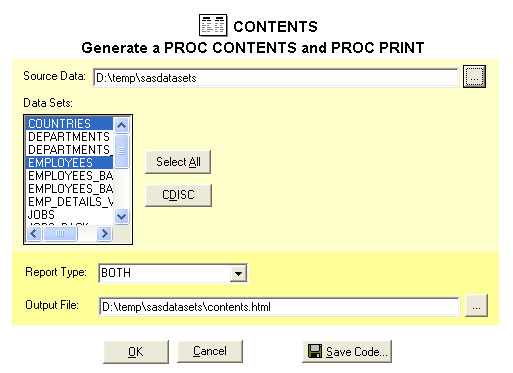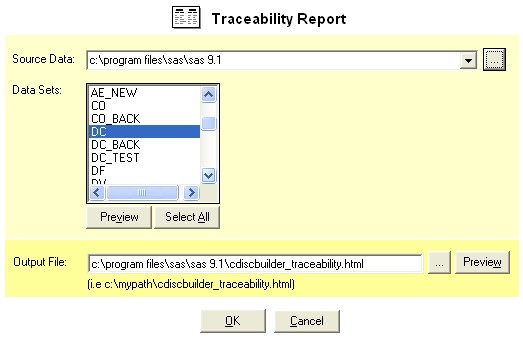|
Overview
You can produce common system level reports for CDISC Builder.
These are not necessarily pertaining to CDISC data structures but include
information such as:
These reports can be accessed
through the REPORT icon from the main CDISC Builder screen. The
selection of the report can therefore be selected with the following
screen.

Audit
Trail
It is very useful to be able to figure out what has been applied to
your data in a complete audit trail. This information can help you
determine where discrepancies are introduced since you are able to track
changes. The audit trail report will provide information including
what tools were applied to which data and by whom. An example report
will include the following information:
- CDISC Builder Tool Applied -
Document which CDISC tool was applied
- Input Data - Input SAS dataset
in this operation
- Input Data Path - The physical
path on the server in which this task was applied
- Output Data - Output SAS data
that was produced as a result of this operation
- Output Data Path - The
physical path on the server in which the output data was produced
- SAS Program - Associated SAS
program produced which produced this operation
- Output Report - Report
generated as a result of the operation
- User Name - The user who
applied the task
- Updated Date Time - The date
and time which this report was generated
This report provides a complete
audit trail of all operations applied through CDISC Builder. The
report also provides hyperlinks to associated report items. The
hyperlinks open up a new window documenting the following information
including: input data path, output data path, SAS program, and output
report.
Contents and Print
One of the first and common task applied to datasets before working on
them is to perform a PROC CONTENTS and PRINT on the data. This
allows you to see both the structure and contents of the data. This
tool allows you to perform the task quickly with a few clicks. The
PROC PRINT would result in a very large report so if the data is over 100
observations, the report will only display the first 100 rows.
The contents screen allows you to select the data and associated
options for the CONTENTS component of CDISC. The data flow for this
tool is shown here.
|
Source Data |
 |
CDISC Builder
Contents |
 |
HTML Report
with PROC PRINT/CONTENTS |
|

The options available for
selecting data and options for CONTENTS are:
- Source Data - This is the
location of the dataset that is going to have PROC PRINT and CONTENTS
applied.
- Select All - This allows the
user to select all the dataset that is in the selected library source
path.
- CDISC - This will select all
datasets that have the matching name with prescribed CDISC domain
datasets.
- Report Type - This will
determine if either a PROC REPORT or a PROC CONTENTS will be applied.
It will also have the option to apply both.
- Output File - The HTML report
will be generated at a specified path captured by this parameter.
- Save Code - The code saved in
this location will contain a macro call capturing all the options that
has been selected. This can therefore be executed independent from
this interface as a SAS program.
Multiple or all datasets can be
documented and report at once. You can either select on the
Select All button or click on each dataset listed holding on the control
or shift key.
Traceability
Report
One of the requirements of CRF Part 11 is to be able to provide
documentation of traceability of your output. This means that for
all the data submitted, you would have to document how the data was
derived. The ability to therefore trace from the output data to its
source is essential. This report documents this process. You
would first select the data in which you wish to generate this report from
the following screen.

A sample report that is generated for traceability would look like:
This documents the fact that the
output dataset DC read the dataset AE as input. It was processed
through the program DC.SAS. This also includes hyperlinks so the
user can easily open up the file that contains the data or program in
which is part of the traceability report. |